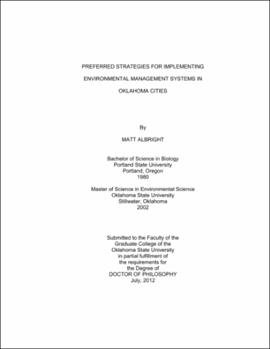| dc.contributor.advisor | Focht, William | |
| dc.contributor.author | Albright, Matt | |
| dc.date.accessioned | 2013-11-26T08:29:46Z | |
| dc.date.available | 2013-11-26T08:29:46Z | |
| dc.date.issued | 2012-07 | |
| dc.identifier.uri | https://hdl.handle.net/11244/7094 | |
| dc.description.abstract | Scope and Method of Study: | |
| dc.description.abstract | The study is regional in scope, exploratory, and utilized a combination of qualitative and quantitative social science methods. | |
| dc.description.abstract | Findings and Conclusions: | |
| dc.description.abstract | Cities throughout the United States are currently under pressure to deliver services and become more sustainable without raising taxes or reducing workforces. They are plagued by compliance problems, consent decrees, solid waste disposal issues, garbage problems, wastewater overflows, air pollution, and a host of other environmental issues. To make matters worse, cities face aging infrastructure, rapid urban growth, drought and water supply problems, rising fuel costs, loss of businesses, stagnant or shrinking budgets, and diminished workforces. | |
| dc.description.abstract | One possible solution to these challenges is the adoption of Environmental Management Systems (EMSs). This study extends the findings of earlier studies of local governmental EMS programs to demonstrate that preferences for EMS implementation strategies can be predicted from ratings of implementation benefits and barriers. Alternative strategies were formulated for Oklahoma cities with populations greater than 20,000. This study demonstrated that a core strategy, which gains city management support, attracts funding, provides training, improves environmental compliance, and yields cost savings can be defined that meets some of the needs of all cities. Additional strategies were defined to address the particular needs of individual cities such as dedicated implementation teams, improved political support, communications, employee buy-in and training, operational and environmental efficiencies and consistency, risk reduction, relationships with regulator and labor relations. The study's conclusions suggest that cities can be encouraged to adopt EMS programs if they are tailored to overcoming the barriers and taking advantage of the perceived benefits as perceived by municipal managers. | |
| dc.format | application/pdf | |
| dc.language | en_US | |
| dc.rights | Copyright is held by the author who has granted the Oklahoma State University Library the non-exclusive right to share this material in its institutional repository. Contact Digital Library Services at lib-dls@okstate.edu or 405-744-9161 for the permission policy on the use, reproduction or distribution of this material. | |
| dc.title | Preferred strategies for implementing environmental management systems in Oklahoma cities | |
| dc.contributor.committeeMember | Payton, Mark | |
| dc.contributor.committeeMember | DeYong, Camille | |
| dc.contributor.committeeMember | Brown, Anthony | |
| osu.filename | Albright_okstate_0664D_12264.pdf | |
| osu.accesstype | Open Access | |
| dc.type.genre | Dissertation | |
| dc.type.material | Text | |
| dc.subject.keywords | cities | |
| dc.subject.keywords | ems | |
| dc.subject.keywords | preferred strategies | |
| thesis.degree.discipline | Environmental Science | |
| thesis.degree.grantor | Oklahoma State University | |
